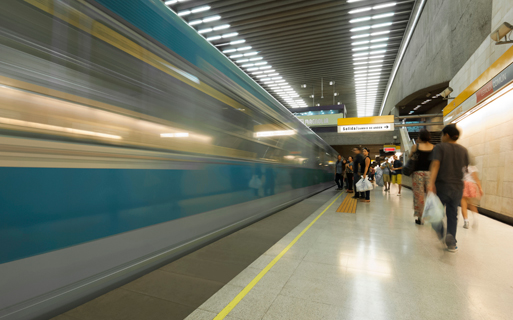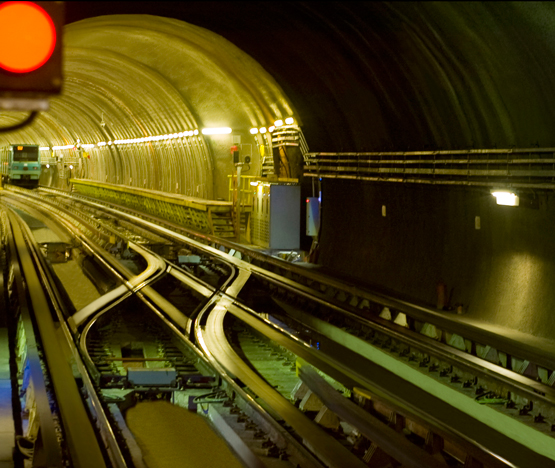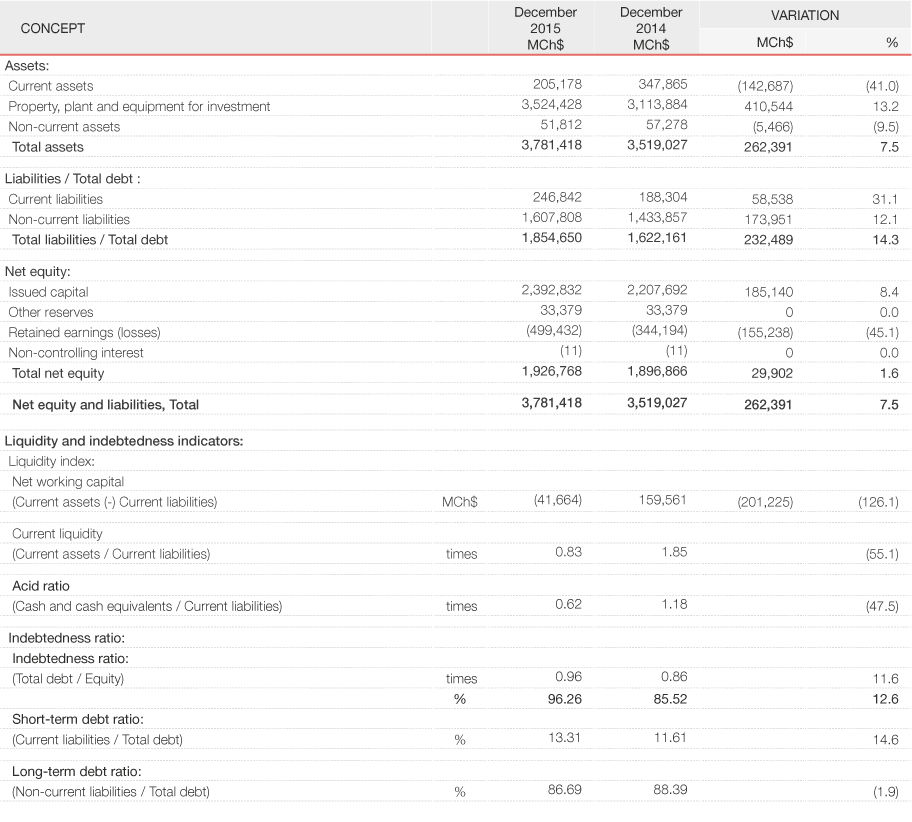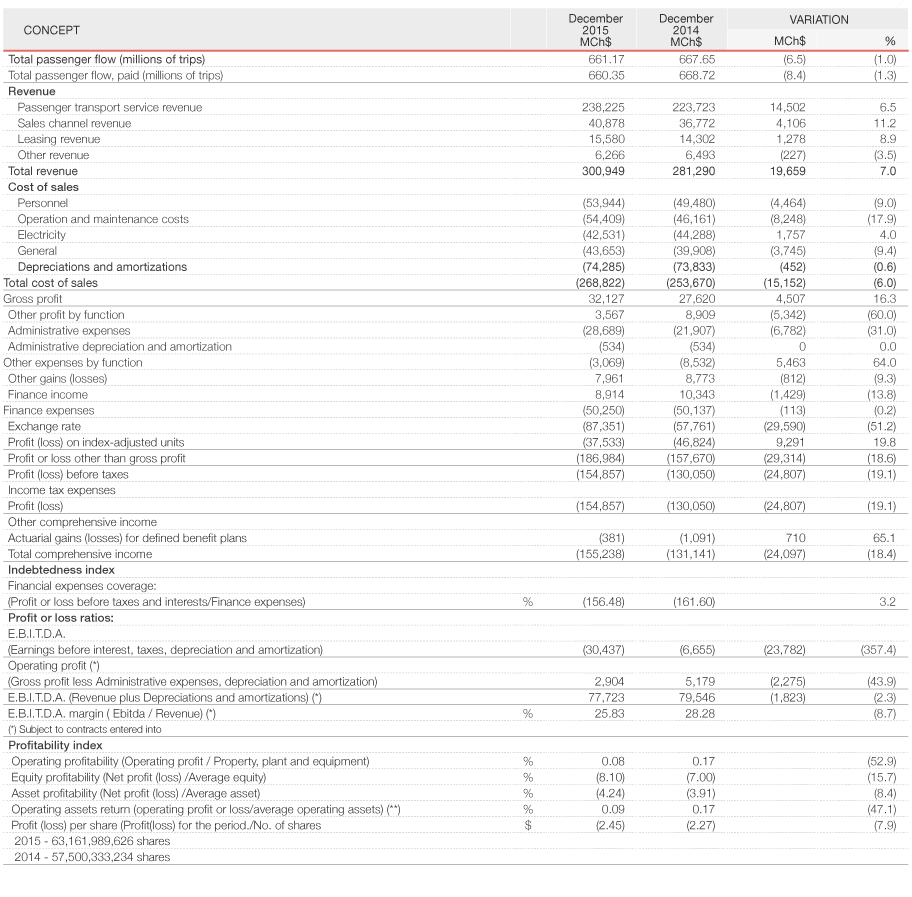This document aims to present an analysis of the economic/financial position of the Company as of December 31, 2015, analyzing the financial structure and its main trends, through comparative tables of the Statements of Financial Position as of December 31, 2015 and 2014, and the Statements of Comprehensive Income as of December 31, 2015 and 2014, expressed in million of Chilean pesos.
Statement of Financial Position
As of December 31, 2015, total Assets and Liabilities amount to MCh$3,781,418, reflecting an increase of MCh$262,391, equivalent to 7.5% compared to December 2014.
In terms of total assets, they are clearly dominated by the fixed portion of the resources. Accordingly, as of December 31, 2015, Property, Plant & Equipment and Net Investment properties represent 93.2% of total Assets. Additionally, current Assets and the other non-current Assets represent 5.4% and 1.4% of total Assets, respectively.

Net Property, Plant & Equipment, and Investment Properties, commercial premises and other properties, granted under operating lease, increased by 13.2% or MCh$410,544- as of December 2015, compared to December 2014, as a result of purchases of properties of MCh$ 486,019- associated to the expansion projects of the Metro subway network, mainly on Lines 3 and 6, that include MCh$468,988 for works in progress, MCh$10,484 for Land, MCh$9,547 for Railway rolling stock and MCh$1,473 for Machinery, equipment and Other. However, a decrease of MCh$4,473 was recorded due to reclassifications to other assets. This was offset by depreciation expenses associated with the Company’s assets (MCh$74,057) and to a lesser extent to transfers to other assets of the Company (MCh$1,993) and disposals (MCh$697). Investment Property increased by MCh$1,272.
Current Assets as of December 2015, decreased by 41.0% (MCh$142,687) compared to 2014, and its variation was mainly due to decreases in Other current financial assets (MCh$72,515) and Cash and cash equivalents (MCh$69,391), resulting from a lower level of investments in long-term and short-term deposits under 90 days. These investments are mainly from the proceeds of the last issue and placement of bonds in the international market for USD$ 500,000,000 on February 4, 2014, and in additions to fiscal contributions received from the Chilean Government. To a lesser extent, the other items that showed a decrease were, Trade and other receivables (MCh$765) and Current Tax Assets (MCh$438). These decreases were partially offset by an increase in other nonfinancial assets (MCh$400) and Inventories (MCh$22). Among the main components of current assets, include the items Cash and cash equivalents (MCh$152,906), Other current financial assets (MCh$25,434), -Financial investments greater than three months-, Trade and other accounts receivable (MCh$9,517), Inventories (MCh$12,163) and Other non-financial assets (MCh$4,216).
As of December 2015, non-current assets, excluding property, plant and equipment and Investment Properties, decreased by 9.5% (MCh$5,466) and its variation was mainly due to the decrease in Other non-financial assets (MCh$12,067), due to transfers to property, plant and equipment originated by the acquisition of land and other property associated with projects for lines 3 and 6. To a lesser extent, Non- current rights receivable decreased MCh$420. This is offset by an increase of MCh$6,000 in Other non- current financial assets, due to the revaluation and increase in the dollar exchange rate in the derivative portfolio –Cross Currency Swap- and to a lesser extent to the increase of MCh$1,021 in Intangible assets other than Goodwill
Total liabilities recorded an increase in all captions where non-current liabilities increased by MCh$173,951, current liabilities increased by MCh$58,538 and equity increased by MCh$129,902. Non- current liabilities increased as a result of an increase in other non-current financial liabilities of MCh$129,107, resulting from a loan assumed of MUS$135, and the increases in exchange rates mainly in bonds and foreign loans. There were other increases in payables due to related parties, non-current which increased by MCh$44,900 as a result of non-capitalized contributions received from the Chilean Government for projects to expand the subway network (Lines 3 and 6) and to a lesser extent because of an increase of MCh$3 in other non-financial liabilities, non-current. This is offset by a decrease in employee benefits of MCh$59. Current liabilities increased as a result of increases in other current financial liabilities of MCh$31,191, trade and other payables of MCh$15,505, other non-financial liabilities of MCh$9,883, current liabilities related to employee benefits of MCh$76 and other current provisions of MCh$1,883.

In terms of Equity, at the Extraordinary Shareholders’ meeting held on December 29, 2015, an increase of share capital issued and subscribed was agreed to through the capitalization of government contributions amounting to MCh$185,140; absorbing the loss for the year of MCh$155,238.
Non-current liabilities (MCh$1,607,808) are comprised by 40.8% (MCh$656,360) of foreign currency obligations, 56.1% (MCh$901,711) in obligations in local currency readjustable and 3.1% (MCh$49,737) for Trade payables due to related parties in local currency non-readjustable. Interest-bearing loans (MCh$306,006) and Public obligations (MCh$350,354) are included in obligations in foreign currency with banks and financial institutions. The readjustable local currency component is comprised of Public obligations (Bonds) of MCh$868,895, Non-current provisions for employee benefits (MCh$13,664), Other non-current non-financial liabilities of MCh$3,485 and megaproject contract withholdings of MCh$15,667. The local currency component is comprised of Accounts payable to related companies for the contributions received by the Chilean Government for various ongoing projects.
In terms of liquidity ratios, net working capital is negative MCh$41,664, which decreased by MCh$201,225 compared to December 2014. Current liquidity ranged from 1.85 to 0.83 times and the acid ratio ranged from 1.18 to 0.62 times. The changes in these ratios is explained by a decrease of MCh$142,687 in current assets (financial investments) and an increase of MCh$58,538 in Current liabilities.
Indebtedness ratios compared with December 2014 present the following variations: total debt-to-equity ratio increased from 0.86 to 0.96 times; the current portion of short-term debt from 11.61% to 13.31%, despite the current portion of long-term debt decreasing from 88.39% to 86.69%.
Statement of Comprehensive Income
As of December 31, 2015, the Company recorded a gross profit (Revenue less Cost of Sales) of MCh$32,127, a Loss of MCh$186,984 for other costs, reaching an after tax loss for the year of MCh$154,857. A loss of MCh$381 for Other comprehensive income is added to the previous result, with a total cumulative loss of MCh$155,238.

In 2015, revenue amounted to MCh$300,949 with an increase of MCh$19,659 (7.0%) compared with last year. Some of the main increases include: Revenue for passenger transportation service (MCh$14,502) mainly due to higher average prices of the technical fare per passenger ($25,22) compared to the average price for 2014, explained by the increase in variables included in the polynomial of indexation, mainly US dollars and Inflation. Notwithstanding this, as of December 2015, an decrease of 6.5 million trips was observed, 1.0% compared to the same date 2014, mainly due to a decrease in passenger flow in May and October of 6.1% and 3.8% respectively, due to a decrease in the level of economic activity in the country. Other increases occurred in Sales channel revenue (MCh$4,106), as Metro S.A. is responsible for the entire sales channel of the transportation system, Transantiago. To a lesser extent, Leasing income increased by MCh$1,278, which was offset by a decrease in Other operating income of MCh$227.
Cost of Sales (MCh$268,822) increased 6.0% (MCh$15,152) compared to December 2014, mainly due to higher Operation and maintenance expenses (MCh$8,248), General expenses (MCh$3,745), Personnel (MCh$4,464) and Depreciation and amortization (MCh$452); despite a decrease in electricity expenses (MCh$1,757).
Energy costs decreased as a result of lower average prices compared to December 2014. It should be noted that since April 2014, the new Electricity Supply Contract with Enorchile S.A. became effective, where the price of electricity is considered a marginal cost (market price) and not a regulated price as in the previous contract. In addition, as a complement to the current Electricity Supply Contract, in September 2015, the Company entered into a New Supply Contract with Chilectra S.A. at a fixed price that will supply up to 40% of the total energy consumption. It will be in effect from October 1, 2015 until December 31, 2023.
General expenses within cost of sales increased mainly due to greater expenses related to the Sales channel, as a consequence of the contract for the provision of complementary broadcasting, after-sales, and commercialization and ticket prepayment services between the Ministry of Transport and Telecommunications and Metro S.A. To a lesser extent, contracts for services received such as security services, IT services, legal services and legal compensation, among others, increased. Operation and maintenance costs were affected by increases in the use of spare parts and tires, rolling stock and tracks maintenance contracts, and other contracts for maintenance mainly related to the increased number of train carriages and their higher average price. To a lesser extent, station maintenance and cleaning costs increased. Personnel expenses varied mainly due to greater payroll and related benefit expenses associated with an increase in the average number of personnel, due to the Company’s greater operating level compared with the previous year. The other factor to consider was the expenses due to negotiation with Union No.2. Depreciation varied due to additions from projects associated with the extension of the metro network, relating mainly rolling stock and electrical equipment.

Results other than gross profit, showed a loss of MCh$186,984 due to the negative effect of Exchange rates of MCh$87,351, MCh$50,250 for Financial expenses - External credits, Bonds and derivative transactions interest, - MCh$28,689 for Management fees, MCh$37,533 for Results from Inflation Adjusted Units, MCh$534 for Depreciation and amortization and MCh$3,069 for Other operating expenses. This was offset by the positive effects of Financial income (MCh$8,914) - Financial Investment Revenue and Other income (MCh$7,961) - Net swap valuation and Other operating revenue (MCh$3,567). Complementing the aforementioned, the loss result of the foreign currency exchange differences, was due to a depreciation of 17.0% of the Chilean peso compared to the US dollar (from Ch$606.75 in December 2014 to Ch$710.16 in December 2015), which generates a greater loss for the year 2015, mainly as a result of liabilities being held in US dollars.
Compared with December 2014, Results other than gross profit increased their loss in MCh$29,314 due to the negative effects of foreign currency exchange differences, which increased their loss by MCh$29,590, Other income by function decreased by MCh$5,342, Management expenses increased by MCh$6,782, Financial income decreased by MCh$1,429, Financial expenses increased by MCh$113 and Other income –swap valuation– increased by MCh$812. This was offset by the positive effect of the increase in Other expenses by function by (MCh$5,463) and a lower loss in Results from Inflation Adjusted Units (MCh$9,291).
Valuation of Main Assets
No information is available regarding differences between the carrying amounts and economic and/or market values that are worth mentioning, except for those that may arise in property, plant and equipment, given the particular characteristics of the Company’s assets, such as tunnels, stations and civil works.
Statements of Cash Flows

Net cash generated from operating activities
As of December 31, 2015 the total net cash generated from operating activities was MCh$92,057, (MCh$101,844) compared to last year. Positive cash flows include: Collection from the rendering of services (MCh$292,847) representing an increase of MCh$12,779 compared with 2014, which represents the main source of the Company’s revenue, which are the transport of passengers, sales channel and non-tariff related revenue (leases). To a lesser extent Other operating activities amounts to MCh$23,063 that mainly include interests and financial investments of less than 90 days and other operating charges.
The negative operating cash flows consists of payments of MCh$148,710 to suppliers for the provision of goods and services, MCh$66,571 for payment to or on behalf of employees and MCh$8,572 for Other payments for operating activities, mainly for payment of property taxes and other.
Operating cash flows are of the same nature as in 2014, reflecting a decrease in positive net cash flow of MCh$9,788 due to higher negative cash flows of MCh$23,333 which are offset to a lesser extent by higher positive cash inflows of MCh$13,545.
Net cash generated from financing activities
Net cash flows as of December 31, 2015 was positive and amounted to MCh$204,430, while the same date last year it amounted to MCh$310,089. As of December 2015, cash was obtained from Loans to related entities of MCh$230,040 corresponding to contributions received from the Chilean government for investment projects, mainly related to the projects associated with Lines 3 and 6, from which MCh$180,303 were capitalized, in addition to a long-term loan received amounting to MCh$95,912. Additionally, within cash outflows are the payment of external loans (MCh$61,264), Interests paid (MCh$50,218) which include External credits and Obligations with the public - Bonds and other cash outflows (MCh$10,040), including the payment of principal installments of bonds and Swap derivative operations.
Positive net cash flow decreased by MCh$105,659 (compared with December 2014) due to lower cash inflows of MCh$282,135, offset by higher cash inflows of MCh$176,476. Negative variations include MCh$277,536 for lower Other cash inflows and MCh$4,599 for lower cash inflows from the issuance of shares. Positive variations include MCh$95,912 for higher cash inflows from long-term loans, MCh$44,900 for Loans to related entities, and lower cash outflows of MCh$35,278 for the payment of loans and MCh$386 for Interests paid.
It should be noted that the significant decrease in cash inflows from other sources of (MCh$277,536), was mainly due to the new issuance and allocation of Bonds in the international market of MUS$500 on February 04, 2014.
Net cash generated from investment activities
As of December 31, 2015, investment activities recorded a negative net cash flow of MCh$372,030, while at the same time last year were also negative and amounted to MCh$335,294. Negative cash flows include: MCh$432,118 for the purchase of property, plant and equipment, mainly associated with the Line 3 and 6 projects, MCh$1,004 for the purchase of intangible assets (software and easement) and MCh$15,427 for Interests paid (International Bond Financing Cost), offset by MCh$76,519 in Other payments to acquire equity or debt instruments from other entities, relating to time deposit investments for periods greater than 90 days.
Negative cash flows increased by MCh$36,736 compared to last year, due to higher payments for the purchase of property, plant and equipment amounting to MCh$132,529, and higher interests paid for MCh$8,627. This was offset by higher cash inflows from the receipt of debt securities from other entities (redemption of investments grater than 90 days) for MCh$104,256, and to a lesser extent due to a decrease in the acquisition of intangible assets MCh$164.
Increase (decrease) in cash and cash equivalents
At the beginning of 2015, an opening balance of cash and cash equivalents (financial investments not exceeding 90 days) amounted to MCh$222,297. The closing balance of cash and cash equivalents as of December 31, 2015 amounted to M Ch$152,906. Consequently, the net variation in cash and cash equivalents for the year was unfavourable and amounted to MCh$69,391.
In comparison with 2014, the opening balance of cash and cash equivalents amounted to MCh$129,279. The closing balance for cash and cash equivalent amounted to MCh$222,297 and net change for the period was positive of MCh$93,018. The effects of the variation in exchange rates on cash and cash equivalents had a positive effect of MCh$6,153 as of December 31, 2015 as result of an increase in the exchange rate, (17%) mainly US dollars. A positive effect of MCh$$16,379 was recorded at the same date in the prior year.

Market Risk Analysis
The Company faces various risks inherent to the activities performed in the public transportation of passengers, in addition to the risks associated with economic/financial changes in market conditions, accidental events or force majeure, among others.
Pricing structure
The Company is part of the Integrated System of Public Passenger Transport of Santiago. Transantiago, and its tariff revenue is based on the number of transported passengers effectively validated and the technical fare established in Appendix No.1 based on the Tender Conditions for the use of Ways in Santiago.
On December 14, 2012 a new Transport agreement was entered into replacing the aforementioned Appendix No.1, where a flat fee of Ch$302.06 per validated transported passenger was established, using September 2012 as the basis. It is updated monthly by an indexation polynomial, which is included in such new agreement and results in an adjustment for fluctuations in variables associated with the structure of the Company’s long-term expenses (CPI, U.S. dollars, Euros, price of power and electricity). This allows a natural hedge for changes in costs resulting from an increase in any of the variables included in such polynomial.
Passenger demand
The demand for passenger transport is driven by other economic activities. During the period between January to December 2015, a decrease of 6.5 million trips was observed, when compared to 2014, mainly due to a decrease in passenger flow in May and October of 6.1% and 3.8% respectively, due to a decrease in the level of economic activity in the country and the decrease in students flow in the network.
Interest rate and exchange rate risk
In order to reduce the exposure to changes in exchange and interest rates of financial debt, the Company has a Financial Risk Coverage Policy. Within the framework of this policy, the Company performed derivative transactions which amounted to MUS$98 as of December 31, 2015, and placed for the first time, bonds in the international financial market of MUS$500 at a rate of 4.85%, highlighting the high degree of participation of foreign investors, which reached a demand of 7.6 times the amount of the placement. These actions helped reduce de level of exposure to changes in the aforementioned variables.
Accordingly, it is worth noting that the indexation polynomial, through which the technical rate of Metro S.A. is updated, includes the US dollar and Euro variables, among others, which is a “natural hedge” in the long-term cash flow.
Liquidity risk and financial liabilities structure
Tariff revenue associated with Metro´s passenger transportation, in accordance with the new transport agreement, are deducted daily from funds raised by the Company’s Sales Channel, generating the necessary liquidity to cover the Company’s obligations. This income corresponds to 79% of total revenue.
The overall debt structure of the Company is mainly composed of bonds and long-term bank loans, aimed at ensuring financial stability and improving the matching with the maturity terms of the Company’s assets.
Credit risk
Credit risk of accounts receivable from commercial activity (passenger transportation) is limited as 79% of the revenue received by the Company is in cash on a daily basis, while the remaining 21% corresponds to revenue not related to the main business.
Debtors relate mainly to commercial leases, advertising and invoices receivable with low delinquency. In addition, there are no customers who owe significant amounts relative to the total of accounts receivable.
Credit risk of financial assets (cash and short-term investments), is limited as the Company’s Financial Investments Policy aims to reduce risks by means of portfolio diversification, setting maximum investment limits for each bank, as well as considering minimal risk classifications by issuer.

Electricity Supply Risk
One of the main risk factors is the supply of electrical energy required to operate the Metro and the need for service continuity, to avoid interruptions in supply. In this regard, the Company has a feeding system that allows it to reduce exposure to outages, having a direct connection to two points of the Central Interconnected System (SIC), which feeds Lines 1, 2 and 5, as well as two points for the feeding of Line 4. Additionally, please note the following:
- The electricity feeding systems are duplicated and in the event of failure of one of them there is always a backup that keeps the power supply for the regular operation of the network.
- The operational control systems are designed with redundant criteria, i.e., they work in a standby mode, so that in the absence of one of the systems, the other comes into operation immediately, maintaining the normal operation of the network.
- For Lines 1, 2 and 5, in the event of a crash of the Central Interconnected System, the distributing company has defined as a first priority the replenishment of the supply that feeds the center of Santiago, which allows the Metro network to have energy simultaneously, since Metro is supplied by the same feeder.
Accordingly, it should be noted that supplementary to the current Electricity Supply Contract with Enorchile S.A. which is in effect until March 31, 2017, the Company entered into a New Supply Contract with Chilectra S.A. in September, 2015. The contract has a fixed price that will supply up to 40% of the total energy consumption curve, until December 31, 2023.
Comparative Table of the Consolidated Statements of Financial Position

Comparative Table of the Consolidated Statements of Comprehensive Income, by Function

(**) Operating assets are Property, plant and equipment and Investment properties